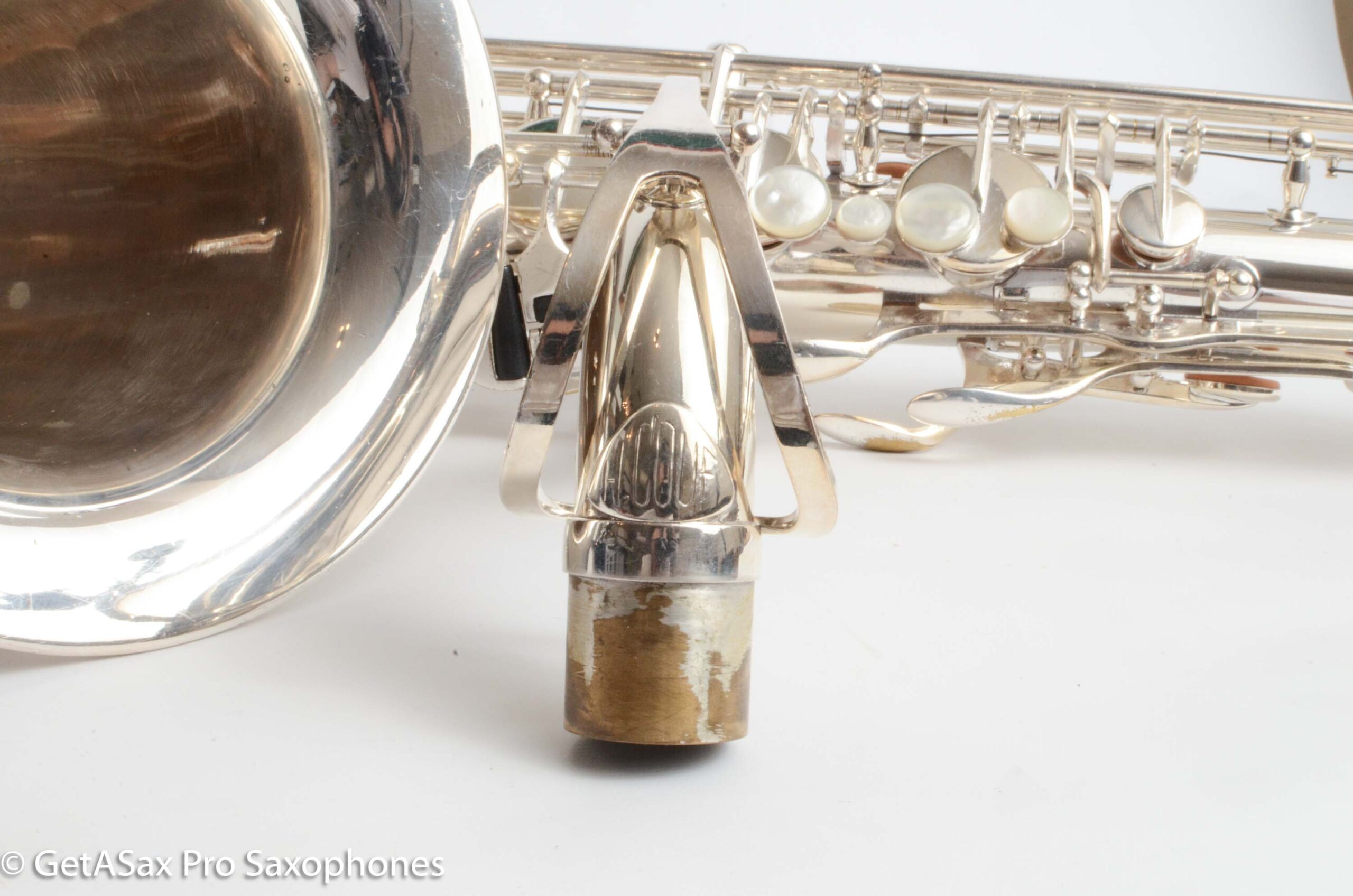Superba 1/I Tenor
I have found that the Superba I tenor has 4 phases based on visual characteristics. These 4 phases are described and illustrated below. Additionally however, there are also some features that the Superba I had over its entire 20+ year production cycle at Keilwerth. Those will be illustrated first.
It is worth noting that except for one exception at the end of their run, for the most part, the Superba I tenors appear to have followed the Superba I altos in the feature evolution.
Features common over the entire production run
- Black plastic left thumb rest * (see below)
- Circle & 1/2 oval bell to body support brace
- Post to body construction
- Lyre holder attached to socket opposite the neck fastening screw
- Bow to bell connected directly (no connecting ring)
- Bow to body connected directly (no connecting ring)
- Low C key arm has a bend
- RH pinkie keys rounder in shape
- Strap ring a thick, flat ring
- Large MOP buttons without metal edges
- Rolled tone holes
- Hand engraving on the bell & bow
What is the significance of German-styled Arabic numeral 1 vs the Roman numeral I in the engraving?
I asked myself that for years, and I have to say that without someone from JK’s former sax department chiming in for an answer to that question, I suspect we will never know. However, after researching the H. Couf brand for a decade, I have come to the conclusion that there likely wasn’t any significance.
The German-styled Arabic 1 is seen most commonly on the earlier model Superbas. It is worth noting that not all 1’s on the bells are identical, which indicate more than a single engraver was involved.
Why did the engraving ultimately switch from 1 to I? I have a couple of theories, but theories are not proof. Ultimately it likely came down to a decision by H. Couf himself—who was very involved in virtually all aspects of the horns that bore is name.
Phase 1 – features
- Black plastic G# key touch
- Lucite clothes guard (common on JK horns)
- High F# key shaped like the right palm keys
- Chromatic F# key shaped like the right palm keys; located on the side of the body
- Adjustable metal right thumb rest
- Latest (only) serial # seen to date: 54xxx
Defining feature for Phase 1 tenor
Other than the serial number indicating one of the first years of H. Couf production, these early altos have the Lucite pant guard seen on JK saxophones.
Superba I #54xxx – Lacquer
Phase 2 – features
- Identical to Phase 1 except for the clothes guard being metal instead of Lucite.
- Circa 1976 the model engraving on bell was changed to a Roman I (consistent on 768xx onwards)
- Serial # range seen to date: 62436-768xx
Defining feature for Phase 2 tenor
All the features of a Phase 1 horn, but with a metal clothes guard.
Superba I # 65988 – silver plate
Superba I # 76663 – lacquer
Phase 3 – features
- MOP G# key touch
- Metal clothes guard
- High F# key semi-oval MOP
- Chromatic F# MOP button key with tone hole located on back of body tube
- Adjustable metal right thumb rest
- Serial # range seen to date: 78347-81932
Defining features for Phase 3 tenor
There were two important features that immediately make it obvious that we are seeing the first serious evolution of a Couf 1 tenor.
- Keilwerth moved the Chromatic F# to the back of the body from the side, and replaced the right palm key-shaped chromatic F# with a MOP button key.
- The high F# was redesigned to a semi-oval, MOP key touch.
Phase 3 Couf Superba I tenor
Superba I #79231 – Blackgold
Superba I #80439 – delacquered
Phase 4 features
- Identical to Phase 3 horns except that the right thumb rest was switched to a fixed, black plastic one, instead of the adjustable metal one that had been on the horns since Phase 1. * (see below)
- At some point near the end of the production run the high F# key changed shape from semi-oval MOP, to rectangular upright. (First seen on #90967.)
- Serial # range seen to date: 81xxx – 91373
Defining features for Phase 4 tenor
- The only visible difference that allows us to see that any Superba I tenor is a Phase 4 horn is that the right thumb rest changed to a fixed, black plastic version from the adjustable metal version that was the norm in all horns Phases 1-3. (Pics 1 &2 below)
- The very last of the Superba I tenors had upright metal high F# keys. (Pics 3 & 4 below) (This is different than the altos that appear to have kept their same high F# key shape once it was introduced.)
Phase 4 Couf Superba I tenor
Superba I #83040 – Lacquer
Superba I # 91373 – Lacquer
NB: Of course there have to be exceptions. Here are the ones I have found to date:
- # 768xx had its left thumb rest removed and replaced with a flat rubber pad.
- Towards the end of their production cycle, Superba I tenors had their high F# key redesigned to an upright metal key. It lost its semi-oval MOP design. The earliest I have seen this feature to date is # 90967. All Superba I tenors after it I have tracked have this same feature, with the latest being # 91373.
- # 885xx had a non-Couf metal replacement right thumb rest




































































































































































































You must be logged in to post a comment.